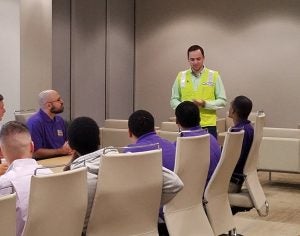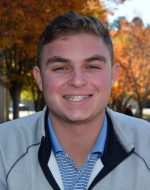IDIS Students Visit East Coast Port

Greg Edwards, the director of external affairs for the Port of Virginia, speaks with IDIS students during recent tour of facilities
On Friday, Nov. 3, more than 20 students from the Industrial Distribution and Logistics (IDIS) program within the College of Engineering and Technology’s Department of Technology Systems took the football team bus to visit the Port of Virginia in Norfolk, Virginia.
This port is the deepest “deep water” port on the East Coast with channel depths of more than 50 feet. It has the most on-dock rail track (nearly 7 miles) and the largest percentage of cargo arriving and departing by rail on the East Coast. Students witnessed the unloading of two container ships by ship-to-shore cranes and automated overhead gantry cranes transferring containers to tractors that will carry those containers to their destinations. The coordinated efforts of ships, cranes and trucks have moved nearly 3 million TEUs (twenty-foot equivalent units) off the port so far this year.
Students were given presentations by Joanne Jenkins, the terminal services manager, and Greg Edwards, the director of external affairs. Presentations included: capabilities of the port, process flow of containers from arrival to destination, scheduling and security measures. Pirate Alumnus Chris Lambert, who now serves as an operations manager at the port, shared how his time at ECU prepared him for the challenges of working at the port.
Caroline Harris, a junior in the IDIS program, stated, “This major has already taught me so much about what a product has to go through before reaching the consumer, and seeing these concepts come to life was fascinating.”
Another student, Justin Soifer, was appreciative of having Lambert at the port. Soifer said, “He gave me a better understanding of potential careers that can come out of the IDIS program.”
Assistant professor, Scott Abney remarked, “It’s one thing to teach students the material, but it’s quite another to show a real-world demonstration of how coursework is applied in industry. Having that visualization of what was going on drove home many points. We are fortunate of the port’s relatively close proximity, and even more so with the (port) staff taking time out of their day to host our university.”


